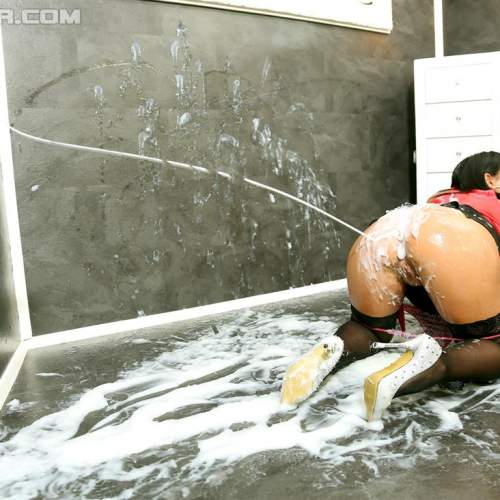|
|
|||
| forums: groups: | |||
|
"Advice--keeping indoor mudpit warm"
We're planning an indoor mud pool of some kind. It will be in a separate room in the basement, complete with a shower, but the question is - - - how do you keep the clay in a pool at a comfortable temperature?
We were thinking of using a pond insert, and using some type of in-floor heating below it, but I'm not sure how efficient that would be, or if the pond material might melt?
I have seen where other people have built such clay pits, and wonder if anyone might share some advice?
We were thinking of using a pond insert, and using some type of in-floor heating below it, but I'm not sure how efficient that would be, or if the pond material might melt?
I have seen where other people have built such clay pits, and wonder if anyone might share some advice?
contact MudMadPhil He build a full claypit and he is still here, and is a bloody genius about this stuff.
Bark Bark Bark
We looked at loads of options to keep our dunk tank warm, never really found one that actually worked to be honest. Fo a mud pit you might find some kind of underfloor heating mats might work but we never found a workable solution.
www.gungetankbabes.com
Im sure i read somewhere sometime ago that candy custard put an electric blanket under hers...i stand to be corrected tho..could've been someone else
Thanks everyone. MudMadPhil kindly got back to me regarding this topic and suggested copper piping with hot water going through. That is probably the course we will take.
All suggestions appreciated though, thanks again!
All suggestions appreciated though, thanks again!
Regis said: Aren't you worried about melting the dolls?!
I literally spat out some of my drink!

We are going to try PEX plastic tubing with heated water circulating though it.
If its going to be a permanent fixture then you want some kind of underfloor heating like mudmadphil
but for my one (I like to have it portable rather than permanent and the ability to switch out the mud for something different like gunge) I mix up my mud or gunge with very warm water to hit the ground running so to speak. I prep the area first with layers of foil sheets to stop the heat vanishing into the floor and then use two electric blankets (they are waterproof and washable these days) and then you also need a cover that touches the surface and has some insulation to keep the heat in and stop it drying out. Works a treat if I remember every step (forget the insulation or one of the blankets and its not as good)
I tried pond heaters but I like my mud thick and it just dried it out almost instantly and then smashed, meaning ruining an expensive batch of mud and having to start again. Pond heaters may work if you have very runny mud like the last batch I did but be very careful
but for my one (I like to have it portable rather than permanent and the ability to switch out the mud for something different like gunge) I mix up my mud or gunge with very warm water to hit the ground running so to speak. I prep the area first with layers of foil sheets to stop the heat vanishing into the floor and then use two electric blankets (they are waterproof and washable these days) and then you also need a cover that touches the surface and has some insulation to keep the heat in and stop it drying out. Works a treat if I remember every step (forget the insulation or one of the blankets and its not as good)
I tried pond heaters but I like my mud thick and it just dried it out almost instantly and then smashed, meaning ruining an expensive batch of mud and having to start again. Pond heaters may work if you have very runny mud like the last batch I did but be very careful
See my sites for tons of other content & coupons
I had a mudbath with a ton of kaolin clay in it in my house for over a decade and kept it warm with a flexible 1" PVC piping system on the sides and a small 20 gallon water heater. You can buy the fexible PVC at a hot tub supply company. If I had it to do over, I'd place the piping at the bottom instead, use the cheaper regular PVC, and put a thin subfloor on top. I used above ground pool liner to contain the mud within the structure. I originally used a spa pump to circulate the water in the piping but eventually stopped using it when I discovered that thermal convection circulated the heat quite nicely.
Note that you will also need to cover the mudbath with something when not in use, both to keep the mud from drying out and to prevent the moisture from causing mold problem in whatever room the mudbath is located in.
Note that you will also need to cover the mudbath with something when not in use, both to keep the mud from drying out and to prevent the moisture from causing mold problem in whatever room the mudbath is located in.
quarryman said: I had a mudbath with a ton of kaolin clay in it in my house for over a decade and kept it warm with a flexible 1" PVC piping system on the sides and a small 20 gallon water heater. You can buy the fexible PVC at a hot tub supply company. If I had it to do over, I'd place the piping at the bottom instead, use the cheaper regular PVC, and put a thin subfloor on top. I used above ground pool liner to contain the mud within the structure. I originally used a spa pump to circulate the water in the piping but eventually stopped using it when I discovered that thermal convection circulated the heat quite nicely.
Note that you will also need to cover the mudbath with something when not in use, both to keep the mud from drying out and to prevent the moisture from causing mold problem in whatever room the mudbath is located in.
Note that you will also need to cover the mudbath with something when not in use, both to keep the mud from drying out and to prevent the moisture from causing mold problem in whatever room the mudbath is located in.
This is great advice. We are building a room for the mud pool, and the mud pool will be a sort of box with a lid, sort of a square version of a hot tub. The room itself will have space for a play pool for other substances, and the entire room will essentially be a shower enclosure, complete with large drain and exhaust fan for moist air. (when showering) The closed lid on the mud area should keep it moist and warm without dampness getting everywhere else. Thanks for your advice! (and everyone else too!)
quarryman said: I had a mudbath with a ton of kaolin clay in it in my house for over a decade and kept it warm with a flexible 1" PVC piping system on the sides and a small 20 gallon water heater. You can buy the fexible PVC at a hot tub supply company. If I had it to do over, I'd place the piping at the bottom instead, use the cheaper regular PVC, and put a thin subfloor on top. I used above ground pool liner to contain the mud within the structure. I originally used a spa pump to circulate the water in the piping but eventually stopped using it when I discovered that thermal convection circulated the heat quite nicely.
Note that you will also need to cover the mudbath with something when not in use, both to keep the mud from drying out and to prevent the moisture from causing mold problem in whatever room the mudbath is located in.
Note that you will also need to cover the mudbath with something when not in use, both to keep the mud from drying out and to prevent the moisture from causing mold problem in whatever room the mudbath is located in.
Did you find the 20 gallon water heater to be overkill? A quick google search finds the inside volume of 1" tubing to be 0.0408 gal/linear foot... so ~25' linear feet of tubing per volumetric gallon. I would imagine a 6 gallon tank would be more than sufficient given that there shouldn't ever be any recovery time in a closed loop system.
Still have all my old flexible PVC piping and went out and measured it just now and it comes in at over 50 feet as I made I made several loops around the enclosure. I'm thinking that the volume and surface area of the mud enclosure would also figure into the equation as well. I always go for overkill anyway when doing home engineering! I never stuck a thermometer down into the mud but the mud temperature was just right, not too hot such that you started sweating immediately and not in anyway cool such that you noticed that when you got in, it was warm, not hot or cool. If I remember correctly, the human body can't cool itself in 80 degree Fahrenheit water so I'm pretty sure the temperature was at least in the high 70's as you would eventually get hot after an hour or so and have to expose yourself to the air to cool down.
I do remember that I kept the thermostat on about a 140 degree heat setting which is lower than what the heater is capable of. The reason I chose a 20 gallon water tank is that they are cheap and easy to find as that is generally what is in a small mobile home. And, they usually come in a nice little round metal container.
And, I forgot to mention, I experimented with the whole water in a waterbed mattress and heater they come with thingy before I built the mudbath and found that it didn't really work. And that is not because the waterbed broke, rather, it is because the water is less dense than the mud on top of it and so the mattress tries to float to the top! Ok, so I then put pool liner on top of the waterbed mattress. No good either as the extra air space thereby introduced weakened the about of thermal transfer as the tiny little waterbed heaters are thermally restricted so as not to overheat the waterbed and melt it so the mud didn't get hot enough. The only thing a waterbed mattress would be good for is that it makes a nice feeling floor but you can do that a lot cheaper and easier with a thin closed cell pad.
When designing your containing structure, keep mind that thick mud is about twice as heavy as an equal volume of water so make sure your structure is engineered to handle that.
I do remember that I kept the thermostat on about a 140 degree heat setting which is lower than what the heater is capable of. The reason I chose a 20 gallon water tank is that they are cheap and easy to find as that is generally what is in a small mobile home. And, they usually come in a nice little round metal container.
And, I forgot to mention, I experimented with the whole water in a waterbed mattress and heater they come with thingy before I built the mudbath and found that it didn't really work. And that is not because the waterbed broke, rather, it is because the water is less dense than the mud on top of it and so the mattress tries to float to the top! Ok, so I then put pool liner on top of the waterbed mattress. No good either as the extra air space thereby introduced weakened the about of thermal transfer as the tiny little waterbed heaters are thermally restricted so as not to overheat the waterbed and melt it so the mud didn't get hot enough. The only thing a waterbed mattress would be good for is that it makes a nice feeling floor but you can do that a lot cheaper and easier with a thin closed cell pad.
When designing your containing structure, keep mind that thick mud is about twice as heavy as an equal volume of water so make sure your structure is engineered to handle that.
Sponsors
To avoid content being blocked due to your local laws, please verify your age ?
Sponsors

Design & Code ©1998-2025 Loverbuns, LLC 18 U.S.C. 2257 Record-Keeping Requirements Compliance Statement
Epoch Billing Support Log In





 Love you, too
Love you, too











































 VIP Coupons
VIP Coupons